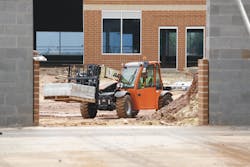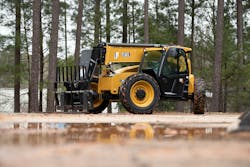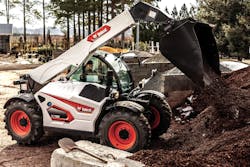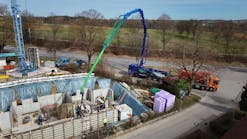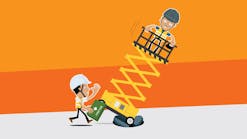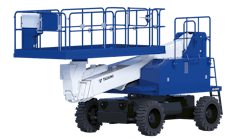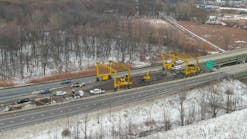Many of the most important developments in the telehandler category have been related to safety and handling loads at height. Load charts, and accompanying safety technologies, have captured the attention of OEMs and are critical for managers to learn about and use.
This is also true for those who rent equipment, as telehandlers are frequently rented and may be used by multiple operators with different levels of experience.
“Increasing operator confidence and productivity on job sites are the biggest drivers with the introduction of new features and technologies for telehandlers,” says Bob Bartley, senior director of product support/service solutions for Genie.
“There are always jobs to be done, and telehandler OEMs, including JLG, continue to look at ways that these machines can help operators do more work, as well as help operators be more effective and efficient in the work they have to do,” says John Boehme, senior product manager, telehandlers, for JLG. “You can see examples of this in the latest telehandler features introduced in the market, which are specifically designed to improve equipment productivity, increase operator confidence, and enhance job site safety.”
How to use a telehandler load chart
“Since telehandlers have the unique potential to extend materials away from the vehicle with the telescoping boom, it is best practice for the machine operator to know that the material it’s lifting, placing, or carrying with pallet forks or any attachment, is within the rated capability of the unit,” Boehme says. “Understanding the elements that go into the successful placement of a load are vital to effectively using a telehandler.”
Every telehandler is equipped with a load chart for each of the different attachments it can support, such as a fork carriage, bucket, or truss boom.
“Even if you’re using a machine that’s comparable to another telehandler in terms of maximum capacity and reach, the load charts can vary between machines,” says Mitch Fedie, product manager at Pettibone. “Refer to the boom angle indicator and the boom section indicator on the boom, and line it up with the load chart.
“Consulting the load chart is a must when operating any telehandler, but particularly for units with outriggers, where the specified load capacities will significantly change depending on whether the outriggers are up or down,” Fedie says.
“The load capacity chart highlights two key elements: a telehandler’s operating range and its operating envelope,” Boehme says.
The operating range reflects minimum and maximum boom angles, as well as fully retracted and extended boom positions. The operating envelope is located relative to the load center position of the attachment being used.
“To effectively utilize the load capacity chart, you must initially determine some basic criteria: the weight of the product being elevated; the desired height or reach that needs to be achieved; and the model’s load capabilities,” Boehme says.
“Once you have successfully paired the weight and telehandler model, you can use the load chart to assess the load placement or retrieval position,” Boehme says. “Because boom angles and extensions are an integral part of every load capacity chart, you will use boom angle and extension information to place or retrieve the intended load at the required height and reach.
“As an example, using the nearby load capacity chart for reference, if you need to place a 5,000-pound palletized load, with a load center of 24 inches, at a height of 20 feet and a reach of 10 feet, the rental store would suggest that you opt for utilizing a fork carriage attachment,” Boehme says.
“Knowing this is the attachment you will be using, when you review your telehandler’s load capacity chart, you would determine that the boom angle indicator should read 40 degrees and the boom extension, visible from the side of the boom, will be the black ‘D’ zone to successfully place the load,” Boehme says.
Genie has additional advice by way of its Aerial Pros blogs: Always center the load on the forks and position the load so that it is completely against the back of the fork frame. Fork length should always be at least two-thirds the load length.
Genie says all its telehandler fork carriage load charts are also based on a horizontal load center that is 24 inches from the front vertical surface of the fork arm. For loads with a load center exceeding this value, operators need to determine the reduced load capacity for a specific load zone.
Note that this does not account for a load center that is not centered between the forks or a vertical load center exceeding 24 inches from the top face of the fork tine, according to Genie. Keep the load centered on the fork carriage.
To reiterate, two of the most important aspects of telehandler operation, especially when preparing to lift material into place, is to know 1) how much weight needs to be lifted and 2) how high the load needs to be lifted.
“Like larger models, compact telehandlers are generally categorized by maximum lift capacity and/or maximum lift height, and the equipment is rented or sold based on these key attributes,” JLG’s Boehme says. “But contractors can’t assume a higher lift capacity means the unit has a greater maximum lift height. Some models will be designed to lift heavier loads at lower heights.”
Bartley sums up proper load chart use. “It is important when checking out a telehandler’s load chart to look at weight-lifting capacity, but operators also need to look at where the telehandler can lift that weight.
“And don’t forget that the telehandler attachment like a fork, bucket, carriage, or work platform, will also impact the telehandler’s load capacity, load height, and reach,” Bartley says. “Be sure to look at the telehandler’s load chart that corresponds with the attachment being used before starting work.”
Telehandler makers have also incorporated other related safety technologies.
What is load sensing on a telehandler?
“While there is no substitute for knowing the weight and center of gravity of the material being lifted, placed, or carried to ensure the movement can be executed, telehandlers equipped with a Load Stability Indication (LSI) system can aid operators by helping them to remain within the forward load capacity of the telehandler,” Boehme says.
JLG’s LSI system has four primary components. The first is a sensor attached to the rear axle, which is able to measure the weight applied to the rear axle of the vehicle.
The sensor on the rear axle provides the rear axle load measurement to the telehandler control system; the second part of the LSI system. The vehicle control system is the brain of the telehandler, collecting and transmitting data and commands to many parts of the machine.
“The vehicle control system sends data to the LSI display in the cabin of the vehicle, which is the third part of the LSI system,” Boehme says. “It is the LSI display that provides the operator a visual indication of the forward stability status of the vehicle.”
Boehme says there are six levels of indication in the display, progressing from green (load within capability) to orange (load capability nearing limit) to red (load capability at the limit).
If the forward load capability of the vehicle is reached, a red lamp is illuminated on the display.
“When this happens, an audible alarm is activated, and the vehicle control system will stop and prevent further activation of many of the vehicle hydraulic implement functions,” Boehme says. “The only implement functions available to the operator to correct the stability of the vehicle are retract boom [in] and lift boom [up]. When stability of the vehicle has been improved, the audible alarm will turn off and the display will return to orange.”
The fourth and final part of the LSI system is the LSI Override Switch, which the operator may choose to use to continue operating the vehicle with the red lamp illuminated and hydraulic implement functions inhibited.
“The LSI system is always active, not just when the telehandler is stationary and placing loads,” Boehme explains. “Lowering the boom from a high angle, for example, is a function that may quickly affect the forward stability of the vehicle. For that reason, the LSI system considers multiple factors for each boom lower request from the operator and determines how best to react to the request.
“Depending on stability level, boom extension, boom angle, and level of activation requested, the vehicle control system determines the appropriate acceleration and speed at which to execute the boom lower request,” Boehme says. “The operator still has full control to stop the action at any moment, but the vehicle control system will determine the appropriate deceleration to terminate the boom lower request.”
Telehandler safety features
Like earthmovers and many trucks, telehandlers have had back-up alarms for more than a decade. They help bystanders and other operators know when a telehandler is about to reverse or reversing.
Mirrors help the telehandler operator see many obstructions or obstacles behind them, but sometimes mirrors aren’t enough
That’s why some manufacturers, including Genie, offer a rear proximity alarm. It can supplement existing indirect visibility aides to help with identifying surrounding obstacles.
“First introduced in the automotive industry, the rear proximity alarm uses sensors to identify any potential obstacles within close radius to the back of a machine and alerts the operator via visual and audio warnings,” Bartley says.
“Improved efficiency is the No. 1 reason you should consider adding a rear proximity alarm to your fleet of telehandlers,” Bartley says. “Even with mirrors, it’s sometimes difficult to see entirely around the machines and thus getting out to verify a clear path or asking someone to guide them can negatively impact productivity. The sensor will help detect objects directly behind the machine at close range and it has an expanded range to include objects behind the unit’s rear tires at greater distances.”
Of course, Genie points out that this system, as well as other systems being used today, has limitations due to maintenance practices, the size and shape of an object, composition, environmental conditions, and operating range, so operators should not rely exclusively on the alarm system to determine personnel or objects are behind the machine.
“You should also be aware that some larger construction companies are beginning to require rear proximity alarms on their equipment and the equipment they rent,” Bartley says.
